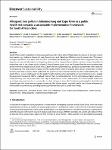Item Infomation
Full metadata record
| DC Field | Value | Language |
|---|---|---|
| dc.contributor.author | Gharbi, Dorra | - |
| dc.contributor.author | Neumann, Frank H. | - |
| dc.contributor.author | Cilliers, Sarel | - |
| dc.date.accessioned | 2023-08-04T08:50:49Z | - |
| dc.date.available | 2023-08-04T08:50:49Z | - |
| dc.date.issued | 2023 | - |
| dc.identifier.uri | https://link.springer.com/article/10.1007/s43621-023-00151-9 | - |
| dc.identifier.uri | https://dlib.phenikaa-uni.edu.vn/handle/PNK/8692 | - |
| dc.description | CC-BY | vi |
| dc.description.abstract | South Africa’s urban population is increasing, and in parallel, urban green infrastructure has shown an increase in alien tree species, e.g., mulberry (Morus sp.), oak (Quercus spp.) and plane trees (Platanus spp.) to name a few. This causes ecological problems since alien trees are often more water-demanding and competitive than indigenous trees, but they also increase the abundance of respiratory diseases often triggered by an allergic reaction towards the pollen of those alien taxa. In the current study, utilizing 7-day volumetric spore traps, we illustrate that the most abundant tree pollen in the two largest cities of South Africa, Cape Town and Johannesburg, is produced by alien trees with a high risk of allergenicity. This adds another aspect related to public health when evaluating plant species composition in urban forestry and urban ecology, which underlines the urgency of more intense monitoring. | vi |
| dc.language.iso | en | vi |
| dc.publisher | Springer | vi |
| dc.subject | Allergenic tree pollen | vi |
| dc.subject | South African cities | vi |
| dc.title | Allergenic tree pollen in Johannesburg and Cape Town as a public health risk: towards a sustainable implementation framework for South African cities | vi |
| dc.type | Book | vi |
| Appears in Collections | ||
| OER - Khoa học môi trường | ||
Files in This Item:

